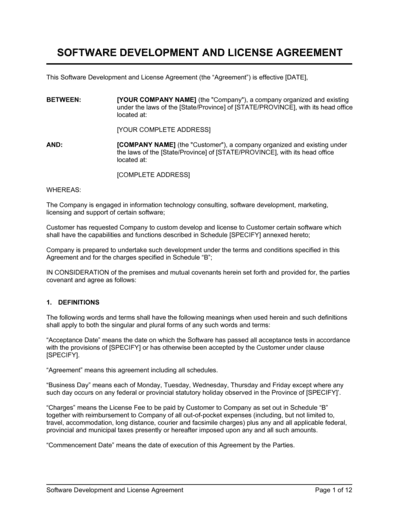
Software Development and License Agreement Template
Securing Software Rights with a Software License Agreement
In the rapidly evolving world of technology, protecting intellectual property and defining the terms of software use are critical for both developers and users. A Software License Agreement is a key document that formalizes the relationship between a software developer (or licensor) and the user (or licensee), outlining the terms and conditions under which the software can be used. This agreement ensures that both parties clearly understand their rights and obligations, fostering a cooperative and compliant usage environment.
A Software License Agreement is essential for defining the parameters of software usage, including the scope of the license, payment terms, restrictions, and intellectual property rights. It provides a legal framework that supports the software's secure and efficient deployment, ensuring that the rights of the developer are protected and the needs of the user are met.
What is a Software License Agreement Template?
A Software License Agreement template is a comprehensive guide for drafting detailed agreements that govern the use of the software. It ensures that all critical elements are addressed, including licensing terms, usage restrictions, payment, and dispute resolution mechanisms. Utilizing a template streamlines the creation process, ensuring consistency and thoroughness while allowing for customization to fit the specific needs and requirements of the parties involved.
Key Elements of a Software License Agreement
A robust Software License Agreement should thoroughly address the following key elements:
- Identification of Parties - Clearly identifies the licensor and licensee involved in the agreement and their respective roles.
- Grant of License - Defines the scope of the license granted, including whether it is exclusive or non-exclusive and any limitations on use.
- License Fee and Payment Terms - Details the payment structure, including license fees, payment terms, and any applicable taxes or additional costs.
- Permitted Use - Specifies the authorized uses of the software, including any restrictions on copying, modification, or distribution.
- Intellectual Property Rights - Confirms that the licensor retains ownership of the software and all associated intellectual property rights.
- Confidentiality - Includes provisions for the protection of any confidential information exchanged between the parties during the term of the agreement.
- Support and Maintenance - Outlines any support and maintenance services provided by the licensor, including response times and service levels.
- Warranties and Disclaimers - Details any warranties provided by the licensor and includes disclaimers to limit liability for certain types of damages.
- Termination - Defines the conditions under which the agreement can be terminated by either party, including notice requirements and post-termination obligations.
- Dispute Resolution - Outlines the mechanisms for resolving disputes, typically through mediation or arbitration, to avoid litigation and maintain a cooperative relationship.
Supporting Documents for Structuring a Software License Agreement
To enhance the functionality and comprehensiveness of a Software License Agreement, integrating the following supporting documents is advisable:
- End-User License Agreement (EULA) - Provides the terms and conditions for end-users, ensuring that all users comply with the software usage guidelines.
- Service Level Agreement (SLA) - Specifies the performance standards and expectations for any support or maintenance services provided, ensuring accountability and reliability.
- Non-Disclosure Agreement (NDA) - Protects confidential information exchanged between the licensor and licensee during the course of the agreement.
Why Employ a Detailed Template for a Software License Agreement?
Utilizing a detailed template for drafting your Software License Agreement offers significant benefits:
- Clarity and Precision - Ensures that all necessary information is clearly presented, reducing the likelihood of misunderstandings or miscommunications.
- Professionalism - Projects a professional image, demonstrating to business partners and users that you are organized and thorough in your approach.
- Efficiency - Streamlines the agreement preparation process, saving time and resources that can be better allocated to strategic initiatives.
- Risk Mitigation - Reduces potential legal disputes by clearly defining roles, responsibilities, and usage restrictions.
- Compliance - Ensures that the agreement adheres to legal and regulatory requirements, reducing the risk of non-compliance and potential legal issues.
Adopting a comprehensive Software License Agreement is essential for protecting intellectual property and ensuring compliant and efficient software usage. It provides a clear, enforceable framework that aligns the parties with their mutual goals, ensuring that the software is used appropriately and remains secure. This fundamental document facilitates operational efficacy and solidifies the commitment to protecting software assets and fostering strategic growth.
Updated in May 2024